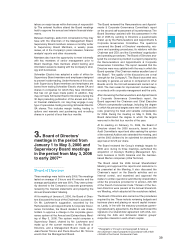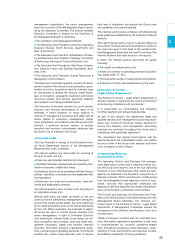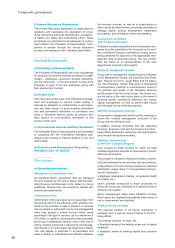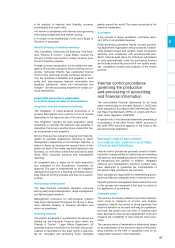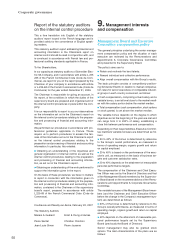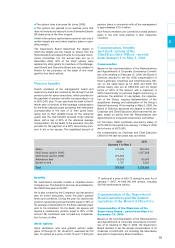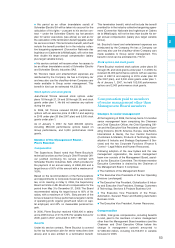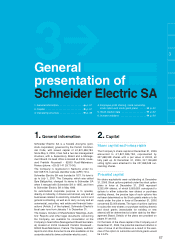APC 2006 Annual Report Download - page 51
Download and view the complete annual report
Please find page 51 of the 2006 APC annual report below. You can navigate through the pages in the report by either clicking on the pages listed below, or by using the keyword search tool below to find specific information within the annual report.
fied in the IFRS accounting framework. This involves
preparing the financial statements on the accrual basis
of accounting and assuming that the business is a
going concern. Qualitative characteristics include
understandability, relevance, reliability and compara-
bility. These characteristics rely on information that is
neutral, prudent and complete and that represents
transactions and events in accordance with their sub-
stance and economic reality and not merely their legal
form.
The management reporting and consolidation pack-
ages of all Group entities are prepared strictly in accor-
dance with Group accounting principles and policies.
The accounting and reporting system
The Corporate Management Control and Accounting
unit of the Finance & Control - Legal Affairs Depart-
ment has launched a project to standardize manage-
ment reporting processes among the various sub-
sidiaries by rolling out an integrated SAP system
across the entire Group. Subsidiaries in France, Spain,
certain other European countries and China have
already migrated their statutory and management
accounting systems to SAP. An SAP core model for
use by all Group entities is currently being developed
and will be implemented in phases between 2006 and
2009.
The accounts of the subsidiaries are prepared in
accordance with Group accounting policies. The data
are then adjusted, where necessary, to produce the
local statutory and tax accounts.
Consolidation and reporting software is used to report
monthly actual and forecast data and also to produce
the Group financial statements.
A new reporting and consolidation system was
deployed on January 1, 2006. In connection with the
migration to the new system, reporting systems were
reorganized (reporting entities, indicators and dead-
lines), completing the process of aligning statutory and
management reporting processes.
Account closing
and verification process
a) Consolidating data from operating units
The reporting entities produce monthly income state-
ments, which are used to determine the Group's
monthly operating profit.
The consolidated financial statements are produced
16 working days after the annual or half-yearly period-
end. To meet this deadline, all of the subsidiaries per-
form a hard close at May 31 and November 30 of each
year and the majority of consolidation adjustments for
the period are also calculated at these dates.
The majority of subsidiaries are consolidated at Group
level; however, the Square D subgroup submits a con-
solidated reporting package.
b) Role of the Corporate Management
Control and Accounting unit
The Corporate Management Control and Accounting
unit includes a reporting team that is responsible for
producing and distributing reporting packages
throughout the Group and a performance analysis
team that tracks the operating units’ performance in
relation to their targets.
The list of entities to be consolidated or accounted for
by the equity method is drawn up by the Corporate
Management Control and Accounting unit, which then
uses this list to determine with the Legal Affairs unit the
consolidation method to be applied to each entity, as
well as the percentage of the entity’s capital and voting
rights held by the Group.
The unit issues instructions for the closing process,
including reporting deadlines, required data and any
necessary adjustments.
It checks the quality of the reporting packages submit-
ted by the subsidiaries, focusing primarily on intercom-
pany eliminations, the accounting treatment of non-
recurring transactions for the period, and movements
between the opening and closing balance sheets used
to prepare the statement of cash flows.
The unit also checks the results of programmed proce-
dures, including conversions, intercompany elimina-
tions, transfers to minority interests and recognition of
the effects of changes in scope of consolidation.
At the same time, the Group's consolidated financial
statements are analyzed in detail, to understand and
check the main contributions by subsidiaries, as well
as the substance of transactions reflected in the
accounts. Account classifications are checked. The key
control points concern the preparation and validation
of the statement of changes in equity and the state-
ment of cash flows.
Lastly, the Corporate Management Control and
Accounting unit analyzes consolidated data and the
contribution of each Group unit.
The Corporate Management Control and Accounting
unit is responsible for providing assurance concerning:
The proper application of Group accounting princi-
ples and policies.
The integrity of the consolidation system database,
which the unit is responsible for administering and
maintaining.
The quality of accounting processes and data.
Training for finance staff in the form of specific sem-
inars.
The unit drafts and updates the financial reporting pro-
cedures and guidelines required to produce high qual-
ity information. These procedures and guidelines are
available for consultation by all employees concerned
on the Group intranet. They include:
A glossary of accounting terms used in the reporting
package, including a definition of each term.
A Group statutory and management accounting
standards manual, which includes details of
debit/credit pairings in the consolidation system.
A Group reporting procedures manual.
A manual describing the procedures to be followed
to integrate newly-acquired businesses in the Group
reporting process.
An intercompany reconciliation procedure manual.
Account closing instructions.
49
2


